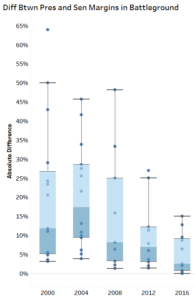Recently, the polling firm Morning Consult released a slew of polls from Senate battlegrounds conducted in the period of September 11th to the 20th. It brought good news for Democrats but one of their biggest obstacles is that they need offensive targets in right leaning seats or even deep red states. Because of this, they will need to rely on split ticket voting, something that has been declared dead or dying. I wanted to take a look at how true that statement was and see if Democrats really could pull off a Senate win. The first table below shows the Senate polling for Morning Consult compared to their presidential polling earlier this month and taken after the RNC, with the average gap sitting at 5%.

I decided to look at all Senate ticket splitting since 2000, partly because the Ross Perot runs messed up a lot of the measurements and this was a clean start. The chart below plots all of the absolute differences in a box plot at the top and below that a line plotting the number of double-digit splits. 2016 still saw a decent amount of ticket splitting, with an average of high single digits though the 75th percentile was lower. There were also not many outliers and the number of double-digit margin splits has been steadily dropping for the last two decades. Most of the Morning Consult polls, and most competitive races, take place in battleground states. I took the same measure and then narrowed it down to states that were decided by 10% or less in the presidential race.
2016 still saw a decent amount of ticket splitting, with an average of high single digits though the 75th percentile was lower. There were also not many outliers and the number of double-digit margin splits has been steadily dropping for the last two decades. Most of the Morning Consult polls, and most competitive races, take place in battleground states. I took the same measure and then narrowed it down to states that were decided by 10% or less in the presidential race. Here you can see 2016 was abnormally low, with a median split of low single digits and smaller maximums than before. If Democrats want to win the Senate and 2020 is like 2016, they will need to hope that there is still a strong showing at the presidential level because they probably won’t be able to run that far ahead of Biden’s numbers.
Here you can see 2016 was abnormally low, with a median split of low single digits and smaller maximums than before. If Democrats want to win the Senate and 2020 is like 2016, they will need to hope that there is still a strong showing at the presidential level because they probably won’t be able to run that far ahead of Biden’s numbers.